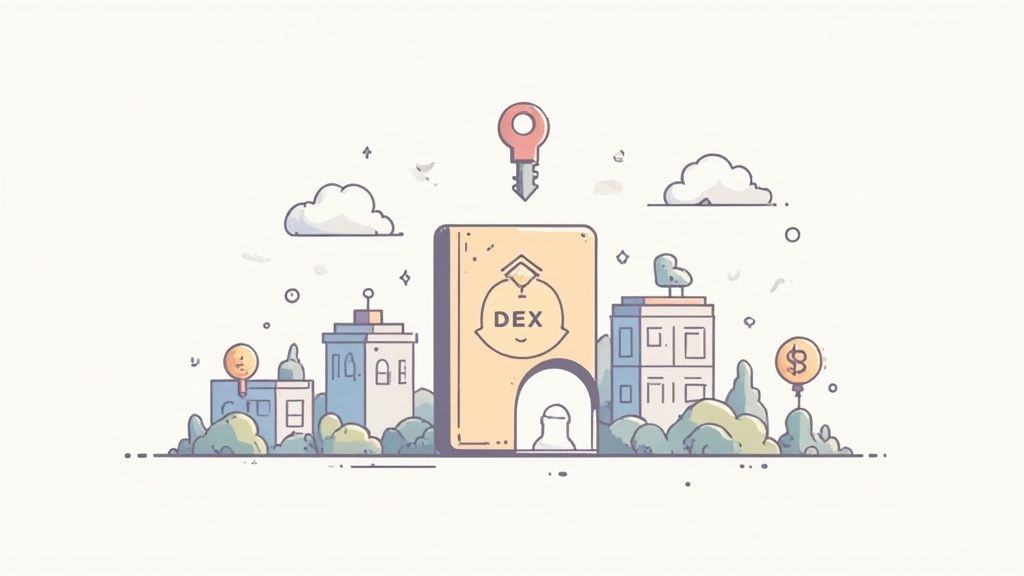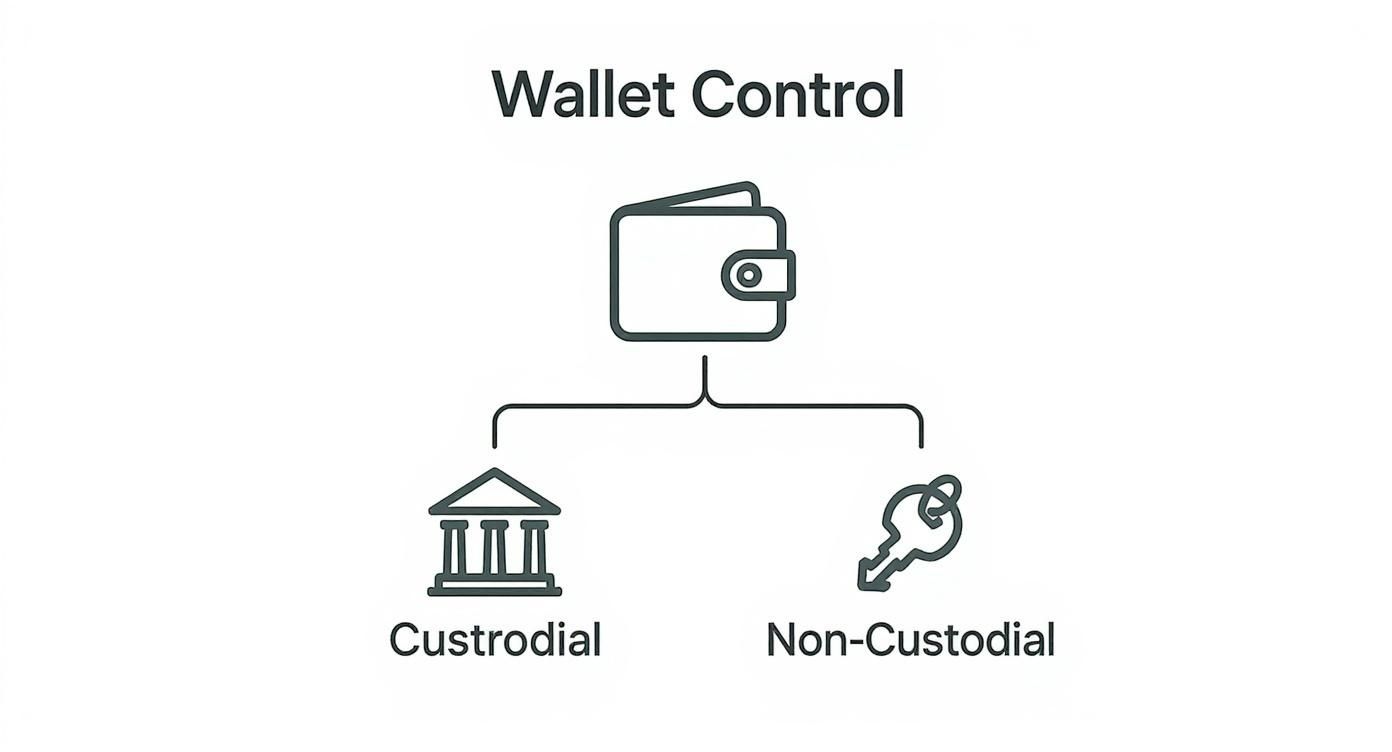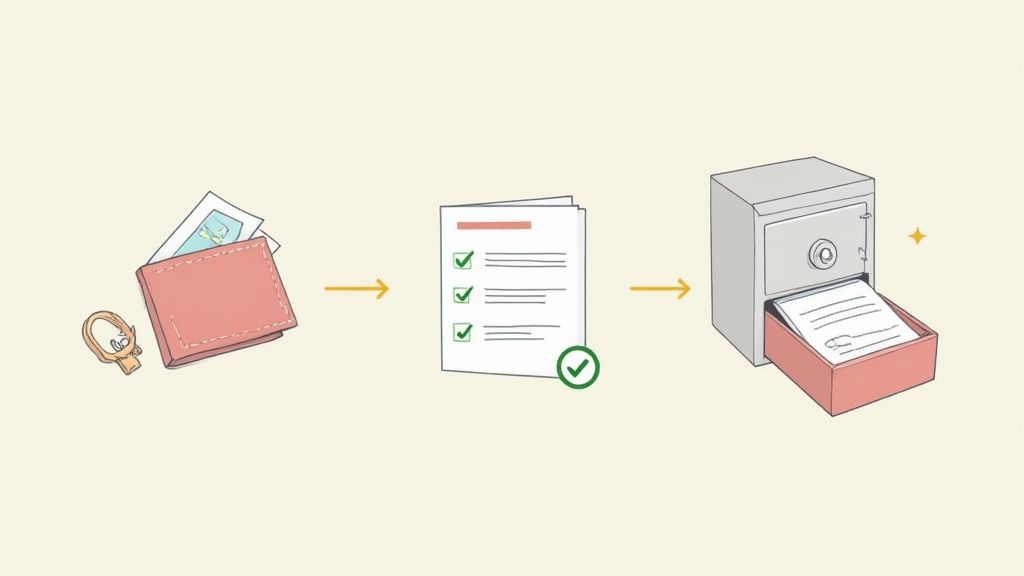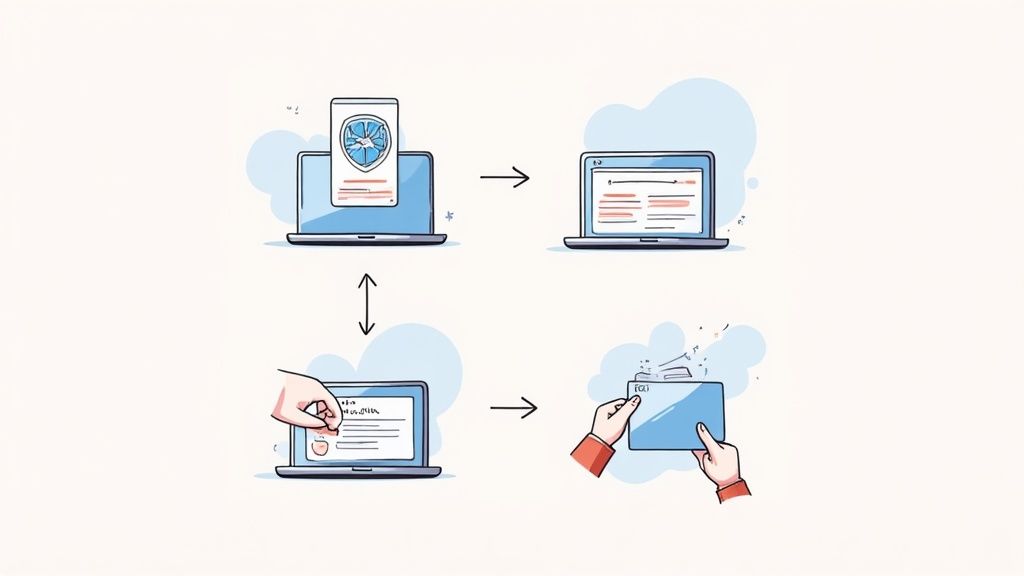Crypto Whale Tracker: A Guide to Smart Money
Discover how a crypto whale tracker unlocks market secrets. Learn to follow smart money, analyze on-chain data, and make smarter trading decisions.

November 20, 2025
Wallet Finder

November 21, 2025

Think of a crypto DeFi wallet as your personal key to the world of decentralized finance. It’s what gives you complete control over your own digital assets, sort of like a digital passport for the entire Web3 ecosystem. With it, you can plug into financial applications without ever needing a bank or a broker.

A DeFi wallet is so much more than just a place to stash your coins; it's the interactive tool that connects you directly to the blockchain. This is a huge shift from traditional finance apps, where a company is ultimately holding your money for you.
With a DeFi wallet, you are the only one with the keys. This is the core idea that lets you trade, lend, borrow, and earn interest entirely on your own terms.
This move toward self-sovereignty is what's fueling the massive growth in this space. It helps to understand how all the pieces of the Web3 world fit together, including how prominent DeFi wallets like MetaMask are enabling this new financial system.
To get started, you just need to grasp a few fundamental ideas. Nailing these down is the first real step toward navigating the DeFi world with confidence.
Here’s a quick breakdown of the terms you'll see over and over.
These concepts might sound technical, but they all boil down to one thing: putting you in the driver's seat.
The growth here isn't just hype. As of early 2025, the Decentralized Finance (DeFi) ecosystem had locked up a total value of over $100 billion across countless blockchains. This explosion is powered by roughly 17.5 million unique DeFi users around the world who depend on these wallets to interact with protocols every single day.
Now that we’ve covered the basics, this guide will walk you through everything from advanced security practices to spotting profitable strategies, making sure you can operate safely and effectively in this exciting space.
When you first jump into crypto, one of the first forks in the road you'll hit is choosing a wallet. The choice boils down to two camps: custodial or non-custodial. Think of a custodial wallet—like the one you get on a big exchange—as a bank’s safety deposit box. The bank holds your stuff for you and manages the keys. It’s convenient, sure, but you're ultimately trusting someone else with your assets.
A non-custodial crypto defi wallet, on the other hand, is your own personal safe. You, and only you, have the combination. This idea of self-sovereignty is the absolute bedrock of decentralized finance, perfectly summed up by the golden rule of crypto: "not your keys, not your crypto." This single difference changes everything about how you own and interact with your digital assets.
With a non-custodial wallet, your funds are secured by math on the blockchain, and they can only be moved with your private keys. This gives you final, undeniable control. No company can freeze your account. No government can seize your funds without those keys. No platform outage can block you from your money.
This is it. This is the core reason non-custodial wallets are non-negotiable for anyone serious about DeFi. You stop being just a "user" of a financial service and become the sovereign owner of your assets, free to plug into any part of the ecosystem without asking for permission.
This empowerment is a huge reason the market has grown so dramatically. The global crypto wallet market, which is dominated by these DeFi-ready wallets, was valued at around $4.18 billion in 2025 and is on track to hit nearly $56.74 billion by 2035. With roughly 65% of digital asset users already using crypto wallets to tap into DeFi, their role as the gateway to financial freedom is undeniable. You can dig into more of the numbers in these crypto wallet market projections and trends.
Getting a handle on the trade-offs between convenience and control is crucial. While custodial services are a simpler entry point for beginners, only non-custodial wallets give you the keys to the entire DeFi kingdom.
This table breaks down the main differences.
When you lay it all out, the choice comes down to one question: Who do you trust to hold your money? For anyone venturing into DeFi, the only real answer is yourself.
The whole point of decentralized finance is to cut out the middlemen. You can't really be part of a permissionless world if you have to ask a third party for permission to use your own money.
Here's exactly why non-custodial wallets are the only way to fly in DeFi:
This freedom, of course, comes with the responsibility of keeping your seed phrase safe. But that’s a small price to pay for complete financial autonomy. When you embrace a non-custodial crypto defi wallet, you're not just storing crypto—you're unlocking an entirely new financial world.
Let's get one thing straight: not all DeFi wallets are built the same. The world of wallet tech is surprisingly deep, and picking the right one is a huge deal for both your security and your sanity. The first, and most important, split you need to understand is between wallets that are always online versus those that are kept completely offline.
This initial choice between "hot" and "cold" storage shapes everything about how you'll interact with your crypto. Are you a high-frequency trader who needs instant access, or are you looking to lock down your assets for the long haul? Your answer to that question will point you in the right direction.
This simple diagram really hammers home the core difference in wallet control—are you letting someone else hold your keys (custodial), or are you taking full ownership (non-custodial)?

As you can see, with a non-custodial wallet, you are the only one with the keys. That’s the entire foundation of self-sovereignty in DeFi.
Hot wallets are exactly what they sound like: software wallets that are always connected to the internet. They usually live on your computer as a browser extension or desktop app, or on your phone as a mobile app. Think of a hot wallet as your everyday spending cash—easy to get to and always ready for action.
Because they’re constantly online, hot wallets are the go-to for anyone actively participating in DeFi. Swapping tokens on a decentralized exchange (DEX), farming yields, or interacting with dApps all become frictionless. Their biggest selling point is pure convenience and speed.
Some of the most popular hot wallets you'll run into are:
But here’s the trade-off: that always-on convenience creates a much larger attack surface. This makes them a poor choice for storing the majority of your crypto portfolio.
On the other end of the spectrum, we have cold wallets. These are physical hardware devices that keep your private keys totally offline. A cold wallet only connects to the internet for the brief moment you need to sign a transaction, and even then, your private key never actually leaves the secure chip inside the device. It’s like keeping your life savings in a bank vault instead of your back pocket.
The core benefit of a cold wallet is that it isolates your keys from online threats like malware, viruses, and phishing attacks. This makes them the gold standard for securely storing large amounts of cryptocurrency over long periods.
Hardware wallets from brands like Ledger and Trezor are the industry leaders here. To send funds, you connect the device to your computer, verify the transaction details on the device’s tiny screen, and then physically press a button to give it the green light. That physical confirmation step is an incredibly powerful security layer.
Once you've got the hot vs. cold distinction down, you can start exploring some of the more advanced wallet types. These offer unique features that cater to serious traders, organizations, or anyone looking for next-level security.
Smart Contract Wallets
These wallets aren't just key containers; they are actual smart contracts living on the blockchain that you control. This opens up some powerful possibilities you won't find in a standard wallet.
Multi-Signature (Multisig) Wallets
A multisig wallet is a wallet that requires more than one private key to authorize a transaction. For example, a "2-of-3" multisig setup would have three authorized signers but requires approval from at least two of them to move any funds. This structure is a game-changer for:
By understanding these different wallet types, you can make a strategic choice that actually fits your goals—whether you’re an active trader, a long-term hodler, or a treasurer for a decentralized organization.

In DeFi, the old saying "be your own bank" is true, but it leaves out the most important part: you also have to be your own security guard. This is the trade-off for having complete control over your money. To protect your assets from the very real threats out there, you need to move beyond generic advice.
A structured security routine is your best defense. It replaces fear with confidence, giving you a clear framework to interact with DeFi protocols while keeping your funds safe. It's all about building specific, repeatable habits that shut down the most common ways people get hacked.
Your seed phrase—sometimes called a recovery phrase—is the single most critical piece of information you'll ever handle in crypto. It's the master key to everything. If someone else gets their hands on it, they can drain your wallet from anywhere on the planet.
The rule here is simple and absolute: never type your seed phrase into a computer, take a picture of it, or save it in a digital file. Think of it like a bar of pure gold; it belongs offline, stored physically, and completely cut off from any internet-connected device.
Consider these tried-and-true methods for keeping it safe:
Exposing this phrase is the number one reason people lose everything. Your discipline here is non-negotiable.
Good security isn't something you set up once and forget about; it's an ongoing practice. By making a few key habits part of your routine, you can dramatically lower your risk. The goal is to create layers of defense so that a single mistake doesn't wipe you out.
Here’s an actionable checklist to get you started:
Use a Hardware Wallet for Signing: Always pair your main hot wallet (like MetaMask) with a hardware wallet (like a Ledger or Trezor). You can start transactions on your computer or phone, but the final approval requires a physical button press on the hardware device. This keeps your private keys completely offline, even while you’re using online dApps.
Periodically Revoke Token Approvals: When you use a DeFi app, you often give it permission to spend your tokens. These approvals can stick around forever, creating a potential backdoor if the protocol gets hacked. Use a tool like Revoke.cash to review and cancel old or unnecessary permissions regularly.
Be Skeptical of Airdrops and Links: Never, ever interact with random tokens that just show up in your wallet. These are almost always dusting attacks or phishing schemes designed to trick you into visiting a malicious site that will drain your funds. The same goes for links sent in DMs on Discord or Telegram—assume they're scams.
Use a Separate "Burner" Wallet: When you want to try a new, unaudited protocol, use a secondary wallet with just a small amount of money in it. This "burner" wallet isolates the risk. If you accidentally sign a malicious contract, the damage is contained and your main stash is untouched.
Attackers are always getting smarter. Phishing scams, for instance, have become incredibly sophisticated, often creating perfect clones of legitimate DeFi websites to steal your credentials. These are a constant threat, and you can learn more about spotting them in our detailed guide on common DeFi wallet scams.
Another huge risk is the malicious contract approval. This happens when you sign what looks like a normal transaction, but you're actually giving a smart contract unlimited permission to spend one of your tokens. Hackers can then use that approval to drain all of that specific token from your wallet whenever they want.
By combining iron-clad seed phrase management with a hardware wallet and a disciplined routine, you build a powerful defense. This proactive approach is what allows you to operate in DeFi with both confidence and control.

Jumping into DeFi is way easier than it looks. It all starts with setting up your first non-custodial wallet, which is your personal gateway to this new financial world.
We'll walk through the process using a browser extension wallet like MetaMask or Rabby. These are the most common starting points for anyone using a desktop computer, and getting the setup right from the beginning is the foundation for everything you'll do in DeFi.
First things first, you need to pick a wallet and install it.
metamask.io or rabby.io. Do not just Google it and click the first ad you see. Scammers love to create fake ads that lead to phishing sites designed to steal your crypto.The installation takes just a couple of minutes, but what comes next is the single most important step in your entire crypto journey. Pay close attention.
After your password is set, the wallet will generate your Secret Recovery Phrase (often called a seed phrase). This is a list of 12 or 24 words that serves as the ultimate backup for your funds. If your computer crashes or you get a new one, this phrase is how you'll restore your wallet.
Your seed phrase is the master key to all your crypto. Its security is 100% your responsibility. If you lose it, your funds are gone forever. If someone else finds it, they can drain your wallet from anywhere in the world. There's no "forgot password" button or customer support line to call.
You need to store this phrase offline, immediately. Here’s how:
Okay, your wallet is set up and your phrase is safely tucked away. Now you're ready to actually use it by connecting to a dApp (decentralized application).
Follow these steps, and you’ll sidestep the common mistakes that catch so many newcomers. Your first experience in DeFi will be secure and successful, setting you up for the road ahead.
Every time you use your crypto defi wallet—whether you're swapping a token, interacting with a dApp, or just sending funds to a friend—you leave a permanent mark on the blockchain.
Think of the blockchain as a giant, transparent public ledger. Your wallet address acts like your account number, and every single transaction is a new line item recorded for anyone to see, forever.
This permanent, public record is your on-chain footprint. While your real-world identity isn't directly linked to your wallet, the entire history of its activity is an open book. This isn't a bug; it's a core feature of blockchain that unlocks incredible opportunities for analysis and research.
If you're new to this idea, it helps to understand what a digital footprint is in a broader sense. Just like your web browsing leaves a trail, your DeFi activity creates a verifiable and unchangeable history of every financial move you make.
This raw, public data is the goldmine that powers sophisticated on-chain analysis. Every successful trader, every crypto fund, and every market-moving "whale" leaves a trail of breadcrumbs on the blockchain. By digging into these on-chain footprints, you can start to reverse-engineer their strategies, spot new trends before they hit the mainstream, and find a real edge.
This is exactly where wallet tracking tools come in. Platforms like Wallet Finder.ai are built to cut through the noise of millions of daily transactions and highlight the signals that actually matter. They act like financial detectives, piecing together clues from the public ledger to show you who's winning and, more importantly, how they're doing it.
Here’s a look at how Wallet Finder.ai turns that messy on-chain data into a clean, actionable dashboard for discovering profitable wallets.
The platform automatically aggregates transactions to calculate key metrics like profit and loss, win rate, and the top-performing assets for any given wallet.
Turning raw blockchain data into strategic insights isn't magic. It's a methodical process of data aggregation and intelligent filtering.
The core idea is simple: if a wallet has a proven track record of making smart moves, its future actions are worth watching. By following the "smart money," you can gain insights that are typically only available to large institutional players.
This approach is becoming more and more common. In 2025, the number of active wallets used for DeFi hit around 198 million globally, making up nearly 24% of all crypto wallets. With cross-chain DeFi wallet transactions surging by 27%, the amount of on-chain data available for analysis is growing exponentially.
Of course, a fully transparent ledger raises valid questions about financial privacy. For users who want to minimize their on-chain footprint, our guide on blockchain privacy and obfuscation techniques is a great place to start. Understanding both the power and the pitfalls of on-chain transparency is key to navigating the DeFi world safely and effectively.
Jumping into DeFi always sparks a few questions. Even after you’ve got the basics down, you might still run into some practical what-ifs. Let's clear up some of the most common ones people ask when they're getting started with their first crypto DeFi wallet.
My goal here is to give you direct, no-nonsense answers so you can navigate the space with a bit more confidence.
Yes, you can—and honestly, you probably should. Using multiple wallets is a pro security move called compartmentalization. It’s all about separating your funds to limit your risk.
Here’s how a lot of seasoned users do it:
That way, if your active hot wallet ever gets compromised, your main stash remains completely safe and sound.
Don’t panic. With a non-custodial wallet, forgetting your password is a hassle, not a disaster. That password you set is just a local security measure; it only encrypts the wallet data on that one specific device. It's not the ultimate key to your funds.
If you lose it, you can simply uninstall and reinstall the wallet. During the new setup, you'll see an option like "Restore from seed phrase." Just punch in your 12 or 24-word recovery phrase, and voilà—your wallet, assets, and history are all back. This is exactly why your seed phrase is infinitely more important than any password.
The fact that you can restore your entire wallet on any device with just your seed phrase is the magic of self-custody. It's what gives you true ownership, independent of any single piece of hardware.
Think of a gas fee as the toll you pay to use a blockchain highway. It's a small charge that goes to the network's validators (the people running the computers) for processing and securing your transaction.
These fees are what keep the network running and secure. The price changes based on how busy the network is. When everyone is trying to make transactions at once, fees go up. When things are quiet, they drop back down.
No. This is one of the hardest and most important rules in crypto: once a transaction is confirmed on the blockchain, it is final and irreversible.
That permanence is a core feature of blockchain—it's what makes the ledger trustworthy. But it also means there's no central bank or customer service line to call if you make a mistake. So, always, always double-check the recipient's address and the amount before you hit that confirm button.
Ready to turn on-chain footprints into actionable trading signals? Wallet Finder.ai helps you discover the most profitable wallets, track their every move, and get real-time alerts so you can act ahead of the market. Start your free trial today and see what the smart money is doing.
"I've tried the beta version of Walletfinder.ai extensively and I was blown away by how you can filter through the data, and the massive profitable wallets available in the filter presets, unbelievably valuable for any trader or copy trader. This is unfair advantage."
.avif)
Pablo Massa
Experienced DeFi Trader